#there are so many award winning scenes of his scattered throughout the series
Text

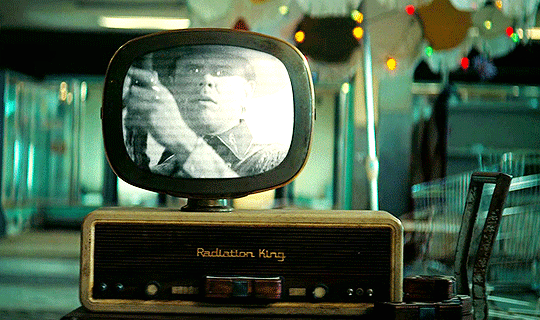
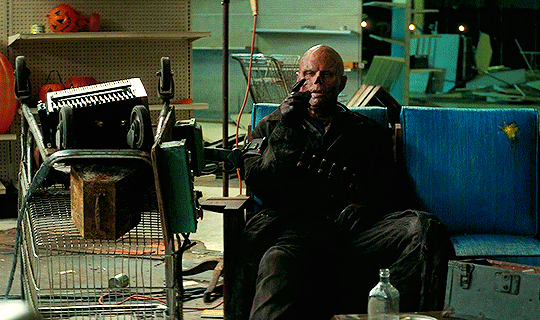
cooper howard
» the ghouls
#Fallout#Cooper Howard#The Ghoul#Walton Goggins#falloutedit#there are so many award winning scenes of his scattered throughout the series#but if I had to choose just one to be the award clip scene#this would be it#because this scene just shattered my heart#Walton absolutely crushed it
546 notes
·
View notes
Text
10 Unmissable Exhibitions To See In 2021!
10 Unmissable Exhibitions To See In 2021!
Art
by Sasha Gattermayr

Hilma af Klint: Paintings for the Future at the Solomon R. Guggenheim in New York. Photo – David Heald.
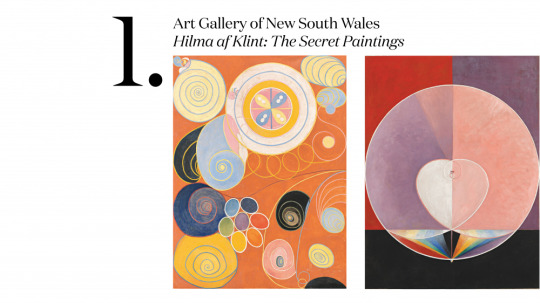
Left: The Ten Largest, Group IV, No. 3, Youth by Hilma af Klint, 1907. Right: Group IX/UW, The Dove No.2 by Hilma af Klint 1915.
Hilma af Klint: The Secret Paintings
12th June – 19th September 2021
Art Gallery of New South Wales
You might recognise the pastel tones and soft, mystical forms of Swedish visionary Hilma af Klint. The 2019 exhibition of her newly discovered paintings at New York’s Guggenheim drew record-breaking crowds, and was broadcast all over Instagram. But nothing substitutes for the real thing!
The 100 works that comprise The Secret Paintings will premiere in the Asia Pacific at the Art Gallery of New South Wales this winter, which will be the first major survey of the experimental artist’s work in the region. The existence of the enormous, ambitious canvases was not known until recently when they found in storage after being kept there for the last few decades… unbeknownst to the art world!
Now brought to light, the dazzling exhibition represents an outpouring of appreciation for the trailblazing modernist artist. Don’t miss this international art sensation!
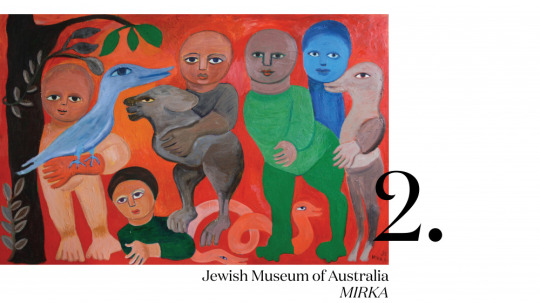
‘Friend Under the Tree‘ by Mirka Mora.
MIRKA
14th February – 19th December 2021
Jewish Museum of Australia, Victoria
It’s no secret we’re HUGE Mirka Mora fans, but this is big… even for us! MIRKA is the most expansive survey of the late, great artist’s work and dives deep into her rich personal history as well as her vibrant creative oeuvre.
After pushing back the opening due to last year’s restrictions, the Jewish Museum of Australia will transform into a ‘Mirka-world’ on Valentine’s Day, featuring more than 200 unseen pieces from the Mora family home and Mirka’s studio and archives. These will be featured alongside pieces from Heide’s permanent collection to create a vivid account of her life as a Holocaust refugee in Australia.
Visitors will be guided through the exhibition of artworks and personal effects by an audio soundscape of stories and memories – narrated by Mirka herself! This will be a truly immersive show of a Melbourne icon.
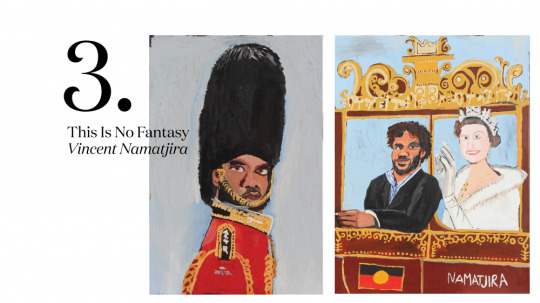
Left: The Royal Tour (Self Portrait 1), 2020. Right: The Royal Tour (Vincent and Elizabeth), 2020.

The Royal Tour (Charles, Vincent and Elizabeth), 2020.
Vincent Namatjira
8th – 25th September, 2021
This Is No Fantasy
2020 was Vincent Namatjira’s year. The artist received an Order of Australia in June, and then took out the prestigious Archibald Prize a few months later, becoming the first Indigenous artist to win the country’s most prestigious portrait prize. AND he released a book in December!
Originally from Ntaria (Hermannsburg), Northern Territory (125km South West of Alice Springs), Vincent identifies as Western Aranda. Today, he is based at Iwantja Arts in the remote community of Indulkana in South Australia’s APY (Anangu Pitjantjatjara Yankunytjatjara) lands.
Vincent’s bold, unique paintings position notable historical figures (often political leaders or members of the British monarchy) in the vivid Australian desert, or himself in diplomatic scenes between international heads of states. His subversive style questions the nature of history and politics we understand today.
This Is No Fantasy gallery represents the of-the-moment artist and will host an exhibition of his recent works later this year. Details are yet to be finalised but mark the date in your diary, it’s going to be excellent!

Left: Cloud formations by Cecilie Bendixen, 2020 and Capitolviscera appliances mural by Jim Shaw, 2011. Photo – Tom Ross. Right: C=O=D=A by Cerith Wyn Evans, 2019–20. Photo – Tom Ross.
Triennial 2020
December 2020 – April 18th, 2021
National Gallery Victoria
Given this all-encompassing contemporary showcase only happens once every three years, its pretty much the defintion of ‘unmissable’.
With pieces scattered throughout the NGV’s permanent collection, the Triennial displays the work of over 100 contemporary designers and artists across many mediums and creative disciplines. From enormous digital landscapes by Refik Anadol to colourful installations by interior designer Danielle Brustman and an enormous iridescent Jeff Koons sculpture, the exhibition celebrates the diversity and of contemporary creatives around the world.
And to really sweeten the deal, entry is free! Make sure to book ahead.

The Lume at MCEC presenting Vincent Van Gogh’s Sunflowers.
The Lume
Permanent installation – opening Autumn 2021 (stay tuned!)
Melbourne Convention Exhibition Centre
Digital art isn’t usually our arena, but an epic-scale digital rendering of classic masterpieces that deposit you INSIDE the painting? Sign us up! The Lume is an immersive art experience that casts projections around a large observation room, enveloping the roaming visitor in the world of a painting.
Opening with the masterpieces of Vincent Van Gogh, visitors enter the world of the Dutch master via a symphony of light, colours, sound and even smells. The moving imagery guides viewers through the Netherlands, Paris and the French countryside, allowing them to visit the locations of the artist’s most famous scenes before arriving at the paintings themselves. The multi-sensory experience gives a sense of Van Gogh’s own thoughts, feelings, emotions and surroundings as he painted.
If quiet, white galleries is not your ideal art-viewing environment, The Lume is for you. It’s like the planetarium of art galleries!

Improvisation No III (Munich) by Erica McGilchrist, 1961.
House of Ideas: Modern Women
1st May – 31st October, 2021
Heide Museum of Modern Art
One of the best things about Heide is the history of the grounds itself, the bedrock of the Australian modernist art movement. House of Ideas: Modern Women celebrates the creative women connected to the iconic site.
From writers to artists, poets and progressive thinkers, these visionary female creatives have been largely forgotten by history, though making just as significant contributions to the bohemian movement as their male counterparts. The exhibition includes the work of Sunday Reed, Cynthia Reed Nolan, Barbara Blackman, Mary Boyd, Joy Hester, Mirka Mora and more to illustrate the central role these women played in creating the cultural and intellectual environment we understand today.

Left: Assemblage of the Fragmented Landscape by Mehwish Iqbal, 2020. Right: Fragile Ecologies by Lauren Berkowitz, 2018.
The National 2021: New Australian Art
The National is a six-year long partnership between three key galleries in New South Wales: the Art Gallery of New South Wales, Carriageworks and Museum of Contemporary Art Australia. This year’s show is the last in a series of three biennial exhibitions, with works spread out across all three locations.
The National: 2021 is a sprawling survey of contemporary Australian art, bringing together artwork from artists of different generations and cultural backgrounds around the country. Thirty-nine artists, collectives and collaboratives present their responses to present-day Australia through a chosen medium, from sculpture to mural to bark painting.
Museum of Contemporary Art Australia
26 March– 22 August 2021
Carriageworks
26th March – 20th June, 2021
Art Gallery of New South Wales
26th March – 5th September 2021
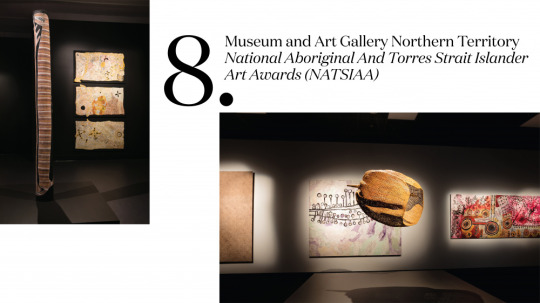
The 2020 finalists on display. Photo – Charlie Bliss.
National Aboriginal And Torres Strait Islander Art Awards (NATSIAA)
Museum and Art Gallery Northern Territory
The Telstra National Aboriginal And Torres Strait Islander Art Awards is a milestone event in the art calendar every year, and the 37th iteration will be no different!
The awards program and accompanying exhibition unites emerging and established Aboriginal and Torres Strait Islander artists at the Museum and Art Gallery Northern Territory in Darwin. The diversity of media displayed among the finalists in the last few years represents the richness of the contemporary art practices among leading Indigenous artists, and the fresh perspectives they bring to the artistic fabric of contemporary Australia. This show is knock-out every year.
Dates are yet to be finalised for this year’s program, but fingers crossed for an IRL ceremony and exhibition!
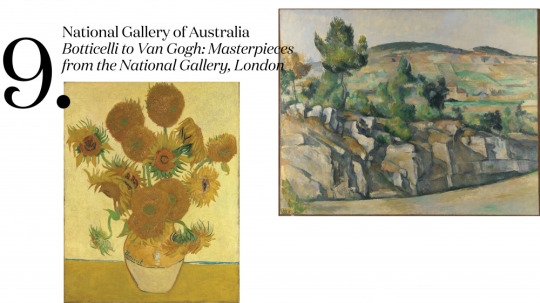
Left: ‘Sunflowers’ by Vincent van Gogh, 1888. Right: ‘Hillside in Provence’ by Paul Cézanne, c1890–92.

‘Four scenes from the early life of Saint Zenobius‘ by Sandro Botticelli, c1500.
Botticelli to Van Gogh: Masterpieces from the National Gallery, London
5 March – 14 June 2021
National Gallery of Australia
Hold onto your hats, there’s a masterpiece blockbuster on its way to Australia!
Spanning five centuries and seven key artistic periods, Botticelli to Van Gogh: Masterpieces from the National Gallery, London brings together 60 paintings by big time European heavyweights including Titian, Rembrandt, Vermeer, Velázquez, Goya, Turner, Renoir, Cézanne and Gauguin. These titans bookend Western European art history, starting with the Italian Renaissance and ending with the birth of modern art, catching the Dutch Golden Age, 17th-century Spanish movement and British portraiture in between.
This showstopper is presented in partnership with the National Gallery, London and is exclusive to the NGA.

The Green Room (Omega Project) by RONE, 2017.
RONE in Geelong
27th February – 16th May, 2021
Geelong Gallery
Rone is a longtime favourite in the TDF office, so just try and stop us from getting down to Geelong to see this!
From stencil works to archival photographs of his signature street murals and digital recreations of his installations, this is the first comprehensive solo survey of the artist’s iconic work. The exhibition culminates in a site-specific piece where one of the gallery’s rooms has been completely transformed into a RONE-style space.
The new multimedia commission will respond to the architecture and history of the building, reforming the grand reception area into a decayed and derelict room – reminiscent of his installations at the abandoned Burnham Beeches building in 2019. It will also contain a new soundtrack by composer Nick Batterham.
0 notes
Text
Get Out: 10 Hidden Details Everyone Completely Missed
Get Out was arguably the best horror film of 2017. It was Jordan Peele's directorial debut and due to its notable success and impact on the genre, the brilliant director is now known as a modern-day master of horror. Get Out was equal parts horror, political commentary and comedy, which made for a unique, thoroughly entertaining film.
The award-winning horror-comedy was undeniably a thrilling experience, but it also held several hidden details and meanings that could only be noticed upon multiple watches.
Jordan Peele loves to hide little Easter eggs in his films and he did the same thing with his latest, Us. There are several brilliant, interesting, and even terrifying hidden details to be dissected and examined in Jordan Peele's Get Out. Let's take a look at some of the major ones.
10 THE TRANSLATION OF THE OPENING SONG

Get Out had an eerie, unforgettable soundtrack that suited its tone perfectly. The unsettling music that plays primarily at the beginning and the end of the film is indecipherable because the singing is in Swahili. The song is called Sikiliza and is completely unnerving.
RELATED: 10 Best Slashers To Watch Before American Horror Story: 1984
This song is more than just creepy, though; it's a warning for Chris. The literal translation of the lyrics played in Get Out is as follows: "Brother, listen to the ancestors - run!" The song sets the tone for the film and for the terrifying journey that Chris is about to embark on.
9 THE SHINING PARALLELS

Jordan Peele has publicly stated on multiple occasions that The Shining is his favorite horror film. This is definitely not an unpopular pick, as the 1980 flick is widely regarded as the best horror film ever made. But it's interesting that Peele has confirmed Stanley Kubrick's masterpiece to be his favorite horror movie, as there are several references to it scattered throughout both Get Out and Us.
Get Out contains many film references, but The Shining was the most referenced. A prominent example is the moment where Andre describes being lost in the suburbs as feeling like being in a hedge maze.
8 JORDAN PEELE'S RABBIT OBSESSION/FEAR

After the notable presence that rabbits had in Us, questions began to arise about Jordan Peele's slight obsession with the animal. In an interview, the writer/director stated that rabbits "terrify" him. In Us, the adorable furballs represented innocence and synchronicity in a sense. But a lesser-known fact is that rabbits were also featured in Get Out but in a less obvious way.
RELATED: The 10 Most Bingeworthy Anthology TV Series, Ranked
The first song played in the film is "Run Rabbit Run," and it's the background music to Andre's death/kidnapping as he wanders through the suburbs.
7 THE DEAD DEER IS A BAD OMEN

The first overt jumpscare in Get Out is the moment when Rose hits a deer during the drive to the Armitage's family home. This scene was also the first time that we see someone being racist toward Chris; the cop that arrives insists on seeing Chris' license even though he wasn't even the one driving.
The deer represents the moment that things started going downhill and the future began to appear dark and menacing. It's a bad omen and Chris' warning song even plays in the background.
6 ROSE DROPPING HINTS

Rose's facade was a hard one to crack, and the reveal of her true motives and identity comes as a shock upon the first viewing of Get Out. But when you look closer, Rose does drop several subtle hints to her sociopathic side throughout the film.
RELATED: 10 Fan Theories That Will Forever Change Your Favorite Horror Movies
One significant example was that she shows no signs of sympathy when she hits and kills the deer early on in the film, while Chris clearly reacts...well, normally.
5 GEORGINA'S SLIP UP

Georgina and Walter are "hosts" for Rose's grandparents, and out of everyone — including Andre — Georgina seemed to slip up the most. Her true identity often came through, albeit in small, easy-to-miss glimpses.
It's been speculated that the moment in which Georgina stumbles while pouring Chris and the Armitage family drinks was brought on by Rose's mother momentarily clinking a spoon to her glass. Missy has the ultimate control due to her hypnosis techniques and this small scene is an example of that.
4 WALTER WAS RUNNING BECAUSE DEAN'S FATHER WAS AN OLYMPIAN

One of the most famous, unforgettable scenes in Get Out was the moment when Walter is running laps in the middle of the night. Chris discovers this anomaly and Walter proceeds to run straight toward him, veering off at the very last second. The scene is shot in a style that portrays Walter running directly at the camera, which makes it all the more memorable.
A deeper look into the reason Walter was running makes a lot of sense; Dean's father — a former Olympic runner — was inhabiting Walter's body, which explains the late-night exercise sessions.
3 HIDDEN LOBOTOMY SCARS

The victims of the Armitage family that are present in Get Out were Georgina, Walter, and Andre. Since the process of inserting someone else's brain into the victim's head and sending them into the Sunken Place was achieved via lobotomy, the victims would obviously have evidence of it, yet none of this is ever visible.
Georgina, Walter, and Andre all had something in common, though; they all wear something on their head that hides their lobotomy scars. Walter/Dean's father wears a baseball cap, Andre/creepy old white guy wears a straw hat, and Georgina/Dean's mother is constantly fixing her hair to hide the scar.
2 METAPHORICAL MEANING OF THE SUNKEN PLACE

The Sunken Place becomes such a terrifying place in Get Out, and the scene in which Missy sends Chris into a hypnotic state and he is slowly plunged into the depths of consciousness was one of the most immersive in the entire film.
Jordan Peele explained that the Sunken Place was a metaphor for the marginalization of African American people. The director stated, "No matter how hard we scream, the system silences us."
1 "A MIND IS A TERRIBLE THING TO WASTE."

The Armitages' extremely disturbing PSA that Chris is forced to watch before they try to take his brain explains the origin of the family's "mission" and why they do what they do. The slogan they used to justify this horrible thing was, "A mind is a terrible thing to waste."
Incidentally, the United Negro College Fund has been using this exact slogan for over three decades, so this is most likely a commentary on white people putting a weird twist on things.
NEXT: 5 Awesome Found Footage Horror Films (& 5 That Don't Work)
source https://screenrant.com/get-out-movie-hidden-details-message/
0 notes
Text
Sensor Sweep: Whisper Network, Bradbury, James Bond, Isle of Dread
H. P. Lovecraft (DMR Books): The first thing to keep in mind is that this cache represents one of the great epistolary friendships in the history of letters. The two never met in person, but the Mutual Admiration Society CAS and HPL formed between them was forged of eldritch steel. Both considered the other the Greatest Living Weird Fiction Author. It is obvious in every letter they wrote and confirmed by comments they sent to other correspondents.
Comic Books (Bleeding Fool): Two weeks ago, we published the second part in our ongoing series of articles investigating the secret “Whisper Network” – a secret group of (mostly) women that’s been allegedly colluding to torment comic book pros and publicly harass creators they disagree with. Within that exposé, a major story was uncovered that should have rocked the comic book industry when it first happened, but was buried or “memory holed” by comic industry press at the time, with sites like Bleeding Fool erasing it after publishing it and Comics Beat, IGN, Newsarama and all others ignoring it entirely.
Cinema (Bounding Into Comics): In a new video interview J.J. Abrams declared that his film production company Bad Robot will make hiring based on looks a top priority. Speaking with Time Magazine about the film industry Abrams discussed what he wants the industry to look like in the future. He then made it clear that Bad Robot will be focused on people’s outward appearance when it comes to hiring.
Robert E. Howard (John C. Wright): As previously announced, Jeffro Johnson, author of Appendix N, Zaklog the Great, Nate the Greater, and your truly gather electronically to talk about Robert E. Howard’s verse….
Ray Bradbury (Pulpfest): Ray Douglas Bradbury was born on August 22, 1920, in Waukegan, Illinois. From an early age, he was a voracious reader and consumer of popular culture — movies, pulp magazines, radio programming, newspaper comic strips, circuses, magic, and more. He was enamored with the Buck Rogers newspaper strip, the stories of L. Frank Baum, Edgar Rice Burroughs, and more. By age twelve, he wanted to write.
James Bond (25 Years Later): Raise your martini glasses! We are only a few months away from (hopefully) another fantastic James Bond adventure (er, at least, we think so. It’s already been delayed once by a global pandemic that is starting to feel like something a diabolical Bond villain would think up). No Time To Die, the 25th official James Bond release, directed by Cary Joji Fukunaga (Beasts of No Nation), stars Daniel Craig for the fifth, and likely final, time as superspy James Bond ending what has been a sterling era for the rugged 52-year-old.
Fiction (Benespen): This is another expedition into the past of popular literature. Abraham Merritt, whose byline is nearly always A. Merritt, was a popular author who wasn’t even best known in his own time for his fiction. Rather, he was a celebrity journalist, making enough money to travel widely and pursue arcane hobbies. The Moon Pool [Amazon link] is the work I usually see cited as typical of Merritt’s work, and it is listed in Gary Gygax’s “Appendix N” as an influence on Dungeons and Dragons. Let’s dive into the Moon Pool and see what happens!
Science Fiction (Starship Cat): This novel is pretty much a direct follow-in to Citadel, and continues to be mostly Dana’s story, with occasional appearances by Butch and some cameos by Vernon Tyler. Dana’s story is pretty much an enactment of the proverbial Chinese curse “May you come to the attention of those in high places.” Her heroism at the end of the last book has made the Powers That Be decide that she’s leadership material — and send her to the new station, to command a squadron from the various Latin American countries.
H. P. Lovecraft (Tentaculii): I’ve encountered an interesting item which perhaps throws a small sidelight on the use of the telephone in Lovecraft’s “The Statement of Randolph Carter” (1919). You’ll recall that a telephone is taken on the descent… The telephone might sound like an unlikely thing to take down below. But wired long-distance field telephones were a known ‘thing’ at that time, not least because of their use in the war.
Conventions (Dragoncon): Part two of our three-part interview series where past Dragon Award recipients talk about their award-winning novels and their Dragon Awards experience. In part one of our three-part Dragon Awards interview series, our award-winning authors talked about their background, what motivates them to write, and about their novels that captured Dragon Awards audiences everywhere.
Cinema (0themastercylinder): William Smith. He was born in 1933 in rural Columbia, Missouri on a cattle ranch. That background served him very well during the many Westerns he was to appear in later. The first big surprise I got in examining his background was how early his film career started. He appeared as a child actor in 1942’s “The Ghost of Frankenstein” as the boy who befriends the Monster portrayed by Lon Chaney Jr.
D&D (Paint Monk): wo years ago, I picked up Goodman Games’ Original Adventures Reincarnated #1, where I re-lived the fun of TSR’s original D&D modules “In Search of the Unknown” and “The Keep on the Borderlands”. This month, I finally picked up OAR #2 – The Isle of Dread, and I’d like to share just how much I enjoyed this book and the work the fine folks over at Goodman put into making it a success.
Fiction (Dark Herald): Been a while since we’ve seen a new Dresden Files book and we will be getting two this year. So at least 2020 isn’t a total write off. Butcher’s last addition to this series was in 2014. He had been rather productive up until this time. Usually producing one or two books a year. I’m not sure why there was a prolonged interrupt, possibly it was his divorce.
Beer (Trinkelbonker): Got these as a delayed birthday gift the other day, six cans of Ace Of Aces American Lager with a rather nice (and collectable, if you ask me) motif. The aircraft you see is an American Lockheed P-38 Lightning and the pilot that flew it was Richard Ira Bong, the first child of nine of Carl Bång, an immigrant from Sweden and Dora Bryce, who was an American by Scots-English descent. Richard, nicknamed Dick by his friends, shot down over 40 Japanese aircraft in the Pacific Theater during WWII and became one of the most decorated pilots of the war.
Game Review (Black Gate): This is the second article in my “explanation” of Conan 2d20. Last time I focused on 2d20’s core mechanic and on this game’s design philosophy insofar as it is an emulation of the “physics” and flavor of Robert E. Howard’s Conan fiction. This one will detail more aspects of gameplay, particularly player character components and action scenes. Last article, I maintained that Conan 2d20 characters begin as powerful in mechanical ability (unless the alternative Shadows of the Past character generation is used).
Cinema (Irish Times): because these things only happen in the greatest superhero movie ever made: Flash Gordon. The 1980 camp classic, which has been restored in 4K to mark its 40th anniversary, has a history of happy accidents following its hero’s first appearance in a comic strip in 1934. Buck Rogers, another intergalactic hero, had already spawned novelisations and toys when King Features Syndicate – a subsidiary of the Hearst newspaper empire – approached Edgar Rice Burroughs with a plan to adapt John Carter into a comic strip.
Small Press (Tentaculii): New on Archive.org…Howard Collector #5, Summer 1964. Howard Collector #6, Spring 1965. With the poem “Who is Grandpa Theobold?”, from a letter. This would count as another early use of ‘Lovecraft as character’, albeit not in fiction. I wonder what the likely year on this poem is?
Cinema & T.V. (Dark Worlds Quarterly): Heroic fantasy films and television changed after 1982. The release of Dino DeLaurentis’ Conan the Barbarian sent Fantasy films in a new direction. Movies had to have a mix of violence, sex and flash that previous movies seemed to lack. Whether you like or hate these films is a matter of opinion. There were bright spots of Fantasy filmmaking among the direct-to-video duds like the Brian Froud-Jim Henson films, Legend by Ridley Scott, and Ron Howard’s The Lord of the Rings known as Willow.
Book Review (Benespen): War Demons [Silver Empire affiliate link] is the veteran’s take on supernatural horror. Sometimes we casually refer to the men who come back from war suffering from PTSD and survivor’s guilt as demon-haunted; but for Michael Alexander it is anything but a metaphor. We now come to the third book covering similar territory I have read recently. I don’t often end up reading lots of similar books together in succession, so I can compare and contrast these.
Science Fiction (Future War Stories): Packed in seemingly every military science fiction work are futuristic firearms and some, like the Colonial Marines M41A1 Pulse Rifle has become an icon of sci-fi weaponry…then there are others that never get their day in the limelight. One of those military sci-fi weapons is the United States standard issue endo/exo assault rifle of the 2060’s: the M590. Featured in the legendary 1990’s FOX one-season TV show Space: Above and Beyond.
Science Fiction (Rough Edges): Robert E. Vardeman has been writing top-notch science fiction for about forty years now, and that’s almost how long I’ve known him. His latest novel, THE DUST OF STARS, is the first book in a new series called ENGINEERING INFINITY, and it’s everything I love about science fiction. First, it has big ideas. And I mean E.E. “Doc” Smith big: An ancient, long-disappeared alien race scattered planet-sized machines throughout the galaxy.
Pulp Fiction (DMR Books): Merritt outlived the CAS-HPL correspondence of 1922-1937, though not by much. In the CAS-HPL letters, one sees Klarkash-Ton belatedly discovering Merritt–and HPL belatedly discovering The Metal Monster. Throughout the course of the correspondence, Merritt was the most successful exemplar of the weird fiction that CAS and HPL were themselves creating. While they did not always agree with the directions he took in his fiction, there was no denying that Merritt dominated the market for pulp fantasy.
Tolkien (Sacnoth’s Scriptorium): So, for years I’ve been convinced that the old story about the Tolkien Estate having gone after TSR for their use of hobbits, ents, balrogs et al in early printings of D&D was wrong and that it was actually Saul Zaentz’s group, Tolkien Enterprises (the movie merchandising people) who’d issued that cease-and-desist back in 1976. But while I’ve able to build up a probable case I’ve been lacking direct proof. Now Gygax has provided it.
Sensor Sweep: Whisper Network, Bradbury, James Bond, Isle of Dread published first on https://sixchexus.weebly.com/
0 notes
Text
Inside Atlanta’s New Beer Hangout: Monday Night Brewing’s Garage
Monday Night Brewing’s Garage opens as a second location in Atlanta. (Credit: Ale Sharpton)
November 27, 2017
It’s just a little past 2 p.m. on a clement October Friday in Southwest Atlanta, and the newest addition to its beer scene—Monday Night Brewing’s Garage, a facility dedicated to sour and barrel-aging beers—is evidently becoming one of the area’s popular chill spots to spark off the weekend.
It’s the second addition to Monday Night’s family; its original brewing headquarters opened in West Midtown six years prior. Compared to its grandiose kickoff two Saturdays ago hosting more than 1,500 people gawking at the complex’s 22,000 square feet unveiling three stainless tanks, two foeders, a koelschip called the Crunkship, chandelier lighting, three taprooms, and beloved native ATL rap group The Nappy Roots rocking the crowd outdoors, the Garage’s current lunchtime serenity would’ve been virtually unimaginable.
Signature glassware at Monday Night Brewing’s Garage, the new sour facility in Atlanta. (Credit: Ale Sharpton)
Visitors mostly in their 20s are sitting at tables scattered throughout the building’s expansive foyer. They are either splitting a pizza from a nearby shop, in a group playing the “Heads Up” charades game yelling clues at someone holding a smartphone to their forehead, or individually pounding away on laptops with headphones; an eclectic mix of lounge grooves, 80s hits and hip-hop from its “Golden Era” serves as the soundtrack for everyone else. The common denominator is they all have the Garage’s signature stemmed glassware containing brews of various hues and styles to help usher in the weekend.
(READ: The Sour Beer Pickle in American Brewing)
At the “Pegboard” taproom bar in the front stands Monday Night co-founder and CMO Jonathan Baker; he is lightheartedly titled “the reasonably qualified creative guy” on the company’s website who handles everything from marketing and branding to social media. Obediently sitting at his side is Eden, a black Labrador and pit bull mix who Jonathan affectionately refers to as literally his “Road Dog”; she accompanies him on constant commutes to both Monday Night locations every day.
Clad in faded jeans, vintage Nikes, and a hoodie boasting a vibrant galactic pattern, Jonathan, 34, adjusts his glasses and studies the list of brews available before making his selection. Laughing, he admits that the last two weeks have been so chaotic that he doesn’t even know what’s currently on tap. Settling on the very popular Han Brolo—an American pale ale at 4.7% ABV—because it’s “super crushable” he says, Jonathan thanks the pourer, and then heads to the next tap station called the “Sticker Taproom Bar” due to all the beer-themed adhesives decorating its base. Eden follows of course.
After making a quick glance at the popular Netflix series “Stranger Things” projected on a white wall adorned with sculpted busts of horned animals, flying predators and dinosaurs to simply “trip people out” he laughs, Jonathan is ready to field questions on Monday Night’s amazing story leading to the Garage.
Monday Night Brewing’s Jonathan Baker thumbs through the beer list at the Garage. (Credit: Ale Sharpton)
Q: Let’s go back to the beginning of Monday Night Brewing. How did it get started and who did you conceptualize it with?
Jonathan: I was in a Bible study with Jeff [Heck] and Joel [Iverson] along with some other guys. It started at Joel’s house first and then Jeff’s for five years; the studies began at 6 a.m. on Fridays for an hour and half each session. Jeff and Joel had both been gifted with homebrewing kits, and the Bible study decided to fire one up on a Monday night at Joel’s house back in 2006. We loved brewing and the community of beer so much that we made our Monday night brew sessions a weekly thing. About three months in, I proposed turning it into a business and it blossomed from there.
We put in as much of our own money as we had. When that ran out—and it ran out quickly—we turned to friends and family, and also applied for an SBA [Small Business] loan.
(BEER TRAVEL: Plan Your Next Beercation)
Q: What were the most difficult obstacles for opening the brewery and why did you pick Atlanta’s Westside?
Jonathan: Understanding the legalities of making and selling beer was one of the biggest obstacles we faced opening a brewery. We knew nothing about the three-tier system, the politics of getting your beer on draft, and how many layers of red tape there are. We spent 18 months simply interviewing and choosing a wholesaler partner for our home market. We opened up our original location on the Westside, a part of town where all three of us had recently moved. This area of town has become a great cultural boon to the city with amazing art, music, and food options. Our brewery is right in the thick of it with ample parking and an amazing patio as well.
Q: Name the first beers you came out with at the original brewery and why those?
Jonathan: We launched with Eye Patch Ale and Drafty Kilt. Eye Patch was a labor of love for us; it’s an English-style IPA that we brewed 24 different ways over the course of five years tweaking and perfecting.
Drafty Kilt was our wild card. There weren’t any breweries in the Southeast brewing a year-round Scotch ale, and very few in the U.S. Drafty Kilt is a toasty Scotch ale with a little Cherrywood-smoked malt and it really helped define us as a brewery in those early days. It’s also won some awards, including a medal at the World Beer Cup. [Monday Night recently won the Silver Medal in the Chocolate Beer category for Tears of My Enemies and a Bronze Medal in the Other Strong Beers category at the 2017 Great American Beer Festival as well.]
(LEARN: How to Choose the Right Glass for Your Beer)
Q: Discuss how the barrel aging began at the original brewery and how that led to the talks about opening the Garage.
Monday Night Brewing’s Garage has three barrel-aging rooms. (Credit: Ale Sharpton)
Jonathan: Our barrel-aging program began with a bourbon barrel version of Drafty Kilt, which actually won a gold at the Great American Beer Festival. It was then that we realized we were on to something. Our barrel program director, Peter Kiley, is a total artist when it comes to barrel aging. He came from winemaking, so he has a knack for working with barrels through that experience. We won a Silver at the World Beer Cup for another barrel-aged creation, Laissez-Faire, a Cabernet barrel-aged wheat wine; from there we decided we needed to expand our barrel program. We really wanted to start getting into sours, which spurred us to start looking off-site for room. Once we toured what is now the Garage, we knew we had something special for our second location. It had such a cool vibe, the potential to be an integral part of the community surrounding it, and frontage to the BeltLine. [The BeltLine is a developing multi-use trail replacing a former rail line going through Atlanta.]
Q: Talk more about the Garage’s concept? Also, why did you pick the West End and how did you get the support from the surrounding community?
Jonathan: It took us about a year from touring the Garage the first time to opening its doors; it was pretty quick, honestly. The name, just like Monday Night, is a reflection of who we are. Peter came up with the ‘Garage’ name over a brainstorming session and some brews one night and it made perfect sense since we homebrewed out of the garage for years.
As for the location, we opened the Garage in the West End to build on these two ideas: community and experimentation. Southwest Atlanta is home to so many vibrant and growing neighborhoods, but it has been a craft beer desert for a while. We wanted to help change that and give these neighborhoods a physical space for them to hang out in. This is an underserved part of the city and part of our mission is to also deepen human relationships. We wanted to have a building and a beverage that pulls people together. That is meaningful to us.
(VISIT: Find a Georgia Brewery)
Q: Talk about what you plan to brew here, the Crunkship, and your future plans.
Jonathan: The Garage is home to Georgia’s first koelschip affectionally named the Crunkship. It is vented to the outside where we have planted an urban orchard replete with fruits like apples, pears, persimmons, grapes, pineapple, guava, cherries, blueberries, strawberries, and others. We’ll be able to pipe in all the air congregating around these plants to ferment. We’ll also be able to use these fruits in the production of our beers.
We have three barrel-aging rooms with different climate controls so that we can operate their humidity and temperature levels independently. We have a primary fermentation room, a souring room and a clean barrel room. In the main production area, we’ve installed some new stainless-steel tanks in addition to two foeders with more to come. We also moved our bottling line down from our original brewery and are in the process of installing a lab.
We have some pretty crazy stuff planned for the future, but what we’re doing here at the Garage is what we call “slow beer.” We want to combine traditional methods of brewing and aging with new ideas and processes. Some of these beers will take years to complete, so I think you’ll really see us hit our stride around 2020. That’s not to say we won’t be putting out good beers until then; we already have some pretty fun stuff in barrels over there, with more on the way.
Dennis Malcolm Byron (aka Ale Sharpton)Author Website
Dennis Malcolm Byron, a.k.a. Ale Sharpton, is a world-renowned beer authority, award-winning journalist, blogger (AleSharpton.com), photographer, event host and gourmand. He has contributed to more than 20 magazines and numerous websites, and passionately travels the globe to cover what he terms the world’s best beverage. Although a native New Yorker and alumnus of Cornell University, he proudly calls Atlanta his home. Globetrot with him on Twitter and Instagram.
Read more by this author
The post Inside Atlanta’s New Beer Hangout: Monday Night Brewing’s Garage appeared first on Miami Beer Scene.
from Inside Atlanta’s New Beer Hangout: Monday Night Brewing’s Garage
0 notes